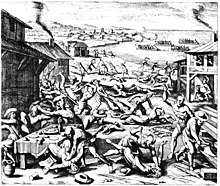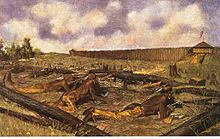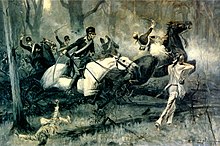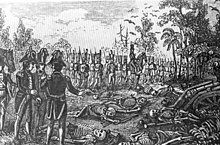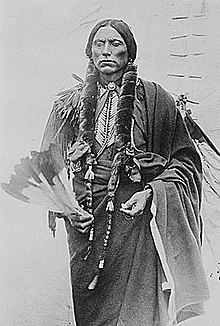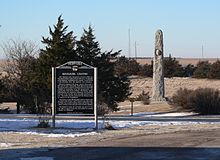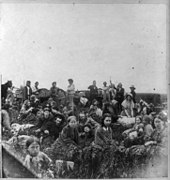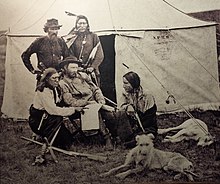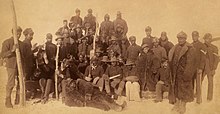| American Indian Wars | |||||||
|---|---|---|---|---|---|---|---|
 An 1899 chromolithograph of US cavalry pursuing American Indians (artist unknown) | |||||||
| |||||||
| Belligerents | |||||||
|
American Indians (1540–1924)
First Nations (1540–1924) Inuit (1542–1924) Aleut (1743–1924) Yupik (1784–1924) Provisional Government of Saskatchewan (1885) |
Republic of Indian Stream (1832–1835) | ||||||
The American Indian Wars (also known as the Indian Wars or the First Nations Wars; French: Guerres des Premières Nations) is the collective name for the various armed conflicts that were fought by European governments and colonists, and later by the United States and Canadian governments and American and Canadian settlers, against various American Indian and First Nation tribes. These conflicts occurred in North America from the time of the earliest colonial settlements in the 17th century until the 1920s. The various Indian Wars resulted from a wide variety of factors, including cultural clashes, land disputes, and criminal acts committed by both sides. The European powers and their colonies also enlisted Indian tribes to help them conduct warfare against each other's colonial settlements.
After the American Revolution, many conflicts were local to specific states or regions and frequently involved disputes over land use; some entailed cycles of violent reprisal. The British Royal Proclamation of 1763, included in the Constitution of Canada, prohibited white settlers from taking the lands of indigenous peoples in Canada without signing a treaty with them. It continues to be the law in Canada today, and 11 Numbered Treaties, covering most of the First Nations lands, limited the number of such conflicts.
As white settlers spread westward across America after 1780, the size, duration, and intensity of armed conflicts increased between settlers and various cultures of Indians. The climax came in the War of 1812, which resulted in the defeat of major Indian coalitions in the Midwest and the South. Conflict with settlers became much less common and were resolved by treaty, often through sale or exchange of territory between the federal government and specific tribes. The Indian Removal Act of 1830 authorized the US government to enforce the Indian removal from east of the Mississippi River to the west, what the government considered the sparsely populated American frontier. (Many tribes had extensive territory in this area, however.) The federal US policy of removal was eventually refined in the West, as American settlers kept expanding their territories, to relocate Indian tribes to specially designated and federally protected reservations.
Colonial period (1540–1774)
Siege of Fort Detroit during Pontiac's Rebellion in 1763
The colonization of North America by the English, French, Spanish,
Dutch, and Swedish was resisted by some Indian tribes and assisted by
other tribes. Wars and other armed conflicts in the 17th and 18th
centuries included:
- Beaver Wars (1609–1701) between the Iroquois and the French, who allied with the Algonquians
- Anglo-Powhatan Wars (1610–14, 1622–32, 1644–46), including the 1622 Jamestown Massacre, between English colonists and the Powhatan Confederacy in the Colony of Virginia
- Pequot War of 1636–38 between the Pequot tribe and colonists from the Massachusetts Bay Colony and Connecticut Colony
- Kieft's War (1643–45) in the Dutch territory of New Netherland (New Jersey and New York) between colonists and the Lenape people
- Peach Tree War (1655), the large-scale attack by the Susquehannocks and allied tribes on several New Netherland settlements along the Hudson River
- Esopus Wars (1659–1663), conflicts between the Esopus tribe of Lenape Indians and colonial New Netherlanders in Ulster County, New York
- King Philip's War (1675–78) in New England between colonists and the Narragansett people
- Tuscarora War (1711–15) in the Province of North Carolina
- Yamasee War (1715–17) in the Province of South Carolina
- Dummer's War (1722–25) in northern New England and French Acadia (New Brunswick and Nova Scotia)
- Pontiac's War (1763–66) in the Great Lakes region
- Lord Dunmore's War (1774) in western Virginia (Kentucky and West Virginia)
In several instances, warfare in America was a reflection of European
rivalries, with American Indian tribes splitting their alliances among
the powers, generally siding with their trading partners. Various tribes
fought on each side in King William's War, Queen Anne's War, Dummer's War, King George's War, and the French and Indian War,
allying with British or French colonists according to their own self
interests. Similarly, Indian tribes differed in their alliances during
the American Revolution and the War of 1812. The Cherokee
supported the British in the Revolutionary War and raided frontier
American settlements in the hope of driving out the settlers, and four
Iroquois tribes fought against the Patriots. Other tribes fought for the
American Patriots, such as the Oneida people and Tuscarora people of the Iroquois Confederacy in New York.
East of the Mississippi (1775–1842)
| Indian Wars East of the Mississippi (post-1775) |
|
British merchants and government agents began supplying weapons to
Indians living in the United States following the Revolution (1783-1812)
in the hope that, if a war broke out, they would fight on the British
side. The British further planned to set up an Indian nation in the
Ohio-Wisconsin area to block further American expansion. The US protested and went to war in 1812. Most Indian tribes supported the British, especially those allied with Tecumseh, but they were ultimately defeated by General William Henry Harrison. The War of 1812 spread to Indian rivalries, as well.
Many refugees from defeated tribes went over the border to
Canada; those in the South went to Florida while it was under Spanish
control. During the early 19th century, the federal government was under
pressure by settlers in many regions to expel Indians from their areas.
The Indian Removal Act of 1830 offered Indians the choices of assimilating and giving up tribal membership, relocation
to an Indian reservation with an exchange or payment for lands, or
moving west. Some resisted fiercely, most notably the Seminoles in a series of wars in Florida.
They were never defeated, although some Seminoles did remove to Indian
Territory. The United States gave up on the remainder, by then living
defensively deep in the swamps and Everglades. Others were moved to
reservations west of the Mississippi River, most famously the Cherokee
whose relocation was called the "Trail of Tears."
American Revolutionary War 1775–1783
The American Revolutionary War
was essentially two parallel wars for the American Patriots. The war in
the east was a struggle against British rule, while the war in the west
was an "Indian War". The newly proclaimed United States competed with
the British for control of the territory east of the Mississippi River.
Some Indians sided with the British, as they hoped to reduce American
settlement and expansion. In one writer's opinion, the Revolutionary War
was "the most extensive and destructive" Indian war in United States
history.
The abduction of Jemima Boone by Shawnee in 1776
Some Indian tribes were divided over which side to support in the war, such as the Iroquois Confederacy based in New York and Pennsylvania who split: the Oneida and Tuscarora sided with the American Patriots, and the Mohawk, Seneca, Cayuga, and Onondaga
sided with the British. The Iroquois tried to avoid fighting directly
against one another, but the Revolution eventually forced intra-Iroquois
combat, and both sides lost territory following the war. The Crown
aided the landless Iroquois by rewarding them with a reservation at Grand River in Ontario and some other lands. In the Southeast, the Cherokee split into a pro-patriot faction versus a pro-British faction that the Americans referred to as the Chickamauga Cherokee; they were led by Dragging Canoe. Many other tribes were similarly divided.
When the British made peace with the Americans in the Treaty of Paris (1783),
they ceded a vast amount of Indian territory to the United States.
Indian tribes who had sided with the British and had fought against the
Americans were enemy combatants, as far as the United States was
concerned; they were a conquered people who had lost their land.
Cherokee–American wars
The frontier conflicts were almost non-stop, beginning with Cherokee
involvement in the American Revolutionary War and continuing through
late 1794. The so-called "Chickamauga Cherokee", later called "Lower
Cherokee," were from the Overhill Towns and later from the Lower Towns, Valley Towns, and Middle Towns. They followed war leader Dragging Canoe southwest, first to the Chickamauga Creek area near Chattanooga, Tennessee, then to the Five Lower Towns where they were joined by groups of Muskogee, white Tories, runaway slaves, and renegade Chickasaw, as well as by more than a hundred Shawnee. The primary targets of attack were the Washington District colonies along the Watauga, Holston, and Nolichucky Rivers, and in Carter's Valley in upper eastern Tennessee, as well as the settlements along the Cumberland River beginning with Fort Nashborough in 1780, even into Kentucky, plus against the Franklin settlements,
and later states of Virginia, North Carolina, South Carolina, and
Georgia. The scope of attacks by the Chickamauga and their allies ranged
from quick raids by small war parties to large campaigns by four or
five hundred warriors, and once more than a thousand. The Upper Muskogee
under Dragging Canoe's close ally Alexander McGillivray
frequently joined their campaigns and also operated separately, and the
settlements on the Cumberland came under attack from the Chickasaw,
Shawnee from the north, and Delaware. Campaigns by Dragging Canoe and
his successor John Watts were frequently conducted in conjunction with campaigns in the Northwest Territory.
The colonists generally responded with attacks in which Cherokee
settlements were completely destroyed, though usually without great loss
of life on either side. The wars continued until the Treaty of Tellico Blockhouse in November 1794.
Northwest Indian War
The Battle of Fallen Timbers
In 1787, the Northwest Ordinance officially organized the Northwest Territory
for settlement, and American settlers began pouring into the region.
Violence erupted as Indian tribes resisted, and so the administration of
President George Washington sent armed expeditions into the area. However, in the Northwest Indian War, a pan-tribal confederacy led by Blue Jacket (Shawnee), Little Turtle (Miami), Buckongahelas (Lenape), and Egushawa (Ottawa) defeated armies led by Generals Josiah Harmar and Arthur St. Clair.
General St. Clair's defeat was the most severe loss ever inflicted upon
an American army by Indians. The Americans attempted to negotiate a
settlement, but Blue Jacket and the Shawnee-led confederacy insisted on a
boundary line that the Americans found unacceptable, and so a new
expedition was dispatched led by General Anthony Wayne. Wayne's army defeated the Indian confederacy at the Battle of Fallen Timbers in 1794. The Indians had hoped for British assistance; when that was not forthcoming, they were compelled to sign the Treaty of Greenville in 1795, which ceded Ohio and part of Indiana to the United States.
Tecumseh, the Creek War, and the War of 1812
Treaty of Fort Jackson with the Creeks, 1814
By 1800, the Indian population was approximately 600,000 in the
continental United States. By 1890, their population had declined to
about 250,000. In 1800, William Henry Harrison became governor of the Indiana Territory, under the direction of President Thomas Jefferson, and he pursued an aggressive policy of obtaining titles to Indian lands. Shawnee brothers Tecumseh and Tenskwatawa organized Tecumseh's War, another pan-tribal resistance to westward settlement.
Tecumseh was in the South attempting to recruit allies among the Creeks, Cherokees, and Choctaws when Harrison marched against the Indian confederacy, defeating Tenskwatawa and his followers at the Battle of Tippecanoe
in 1811. The Americans hoped that the victory would end the militant
resistance, but Tecumseh instead chose to ally openly with the British,
who were soon at war with the Americans in the War of 1812. The Creek War
(1813–14) began as a tribal conflict within the Creek tribe, but it
became part of the larger struggle against American expansion. Tecumseh
was killed by Harrison's army at the Battle of the Thames, ending the resistance in the Old Northwest. The First Seminole War in 1818 resulted in the transfer of Florida from Spain to the United States in 1819.
Second Seminole War
American settlers began to push into Florida, which was now an
American territory and had some of the most fertile lands in the nation.
Paul Hoffman claims that covetousness, racism, and "self-defense"
against Indian raids played a major part in the settlers' determination
to "rid Florida of Indians once and for all".
To compound the tension, runaway black slaves sometimes found refuge in
Seminole camps, and the result was clashes between white settlers and
the Indians residing there. Andrew Jackson sought to alleviate this problem by signing the Indian Removal Act, which stipulated the relocation of Indians out of Florida—by force if necessary. The Seminoles were relatively new arrivals in Florida, led by such powerful leaders as Aripeka (Sam Jones), Micanopy, and Osceola, and they had no intention of leaving their new lands. They retaliated against the settlers, and this led to the Second Seminole War, the longest and most costly war that the Army ever waged against Indians.
In May 1830, the Indian Removal Act was passed by Congress which stipulated forced removal of Indians to Oklahoma. The Treaty of Paynes Landing
was signed in May 1832 by a few Seminole chiefs who later recanted,
claiming that they were tricked or forced to sign and making it clear
that they would not consent to relocating to a reservation out west. The
Seminoles' continued resistance to relocation led Florida to prepare
for war. The St. Augustine Militia asked the US War Department for the
loan of 500 muskets, and 500 volunteers were mobilized under Brig. Gen. Richard K. Call.
Indian war parties raided farms and settlements, and families fled to
forts or large towns, or out of the territory altogether. A war party
led by Osceola captured a Florida militia supply train, killing eight of
its guards and wounding six others; most of the goods taken were
recovered by the militia in another fight a few days later. Sugar
plantations were destroyed along the Atlantic coast south of St. Augustine, Florida, with many of the slaves on the plantations joining the Seminoles.
Attack of the Seminoles on the blockhouse in December 1835
The US Army had 11 companies (about 550 soldiers) stationed in Florida. Fort King
(Ocala) had only one company of soldiers, and it was feared that they
might be overrun by the Seminoles. Three companies were stationed at Fort Brooke
(Tampa), with another two expected imminently, so the army decided to
send two companies to Fort King. On December 23, 1835, the two companies
totaling 110 men left Fort Brooke under the command of Major Francis L. Dade. Seminoles shadowed the marching soldiers for five days, and they ambushed them and wiped out the command
on December 28. Only three men survived, and one was hunted down and
killed by a Seminole the next day. Survivors Ransome Clarke and Joseph
Sprague returned to Fort Brooke. Clarke died of his wounds later, and he
provided the only account of the battle from the army's perspective.
The Seminoles lost three men and five wounded. On the same day as the
massacre, Osceola and his followers shot and killed Agent Wiley Thompson
and six others during an ambush outside of Fort King.
On December 29, General Clinch left Fort Drane with 750 soldiers,
including 500 volunteers on an enlistment due to end January 1, 1836.
The group was traveling to a Seminole stronghold called the Cove of the Withlacoochee, an area of many lakes on the southwest side of the Withlacoochee River.
When they reached the river, the soldiers could not find the ford, so
Clinch ferried his regular troops across the river in a single canoe.
Once they were across and had relaxed, the Seminoles attacked. The
troops fixed bayonets and charged them, at the cost of four dead and 59
wounded. The militia provided cover as the army troops then withdrew
across the river.
The Dade Massacre was the US Army's worst defeat at the hands of Seminoles
In the Battle of Lake Okeechobee, Colonel Zachary Taylor saw the first major action of the campaign. He left Fort Gardiner on the upper Kissimmee River with 1,000 men on December 19 and headed towards Lake Okeechobee. In the first two days, 90 Seminoles surrendered. On the third day, Taylor stopped to build Fort Basinger
where he left his sick and enough men to guard the Seminoles who had
surrendered. Taylor's column caught up with the main body of the
Seminoles on the north shore of Lake Okeechobee on December 25.
The Seminoles were led by "Alligator", Sam Jones, and the recently escaped Coacoochee,
and they were positioned in a hammock surrounded by sawgrass. The
ground was thick mud, and sawgrass easily cuts and burns the skin.
Taylor had about 800 men, while the Seminoles numbered fewer than 400.
Taylor sent in the Missouri volunteers first, moving his troops squarely
into the center of the swamp. His plan was to make a direct attack
rather than encircle the Indians. All his men were on foot. As soon as
they came within range, the Indians opened with heavy fire. The
volunteers broke and their commander Colonel Gentry was fatally wounded,
so they retreated back across the swamp. The fighting in the sawgrass
was deadliest for five companies of the Sixth Infantry; every officer
but one was killed or wounded, along with most of their non-commissioned
officers. The soldiers suffered 26 killed and 112 wounded, compared to
11 Seminoles killed and 14 wounded. No Seminoles were captured, although
Taylor did capture 100 ponies and 600 head of cattle.
Marines searching for the Seminoles among the mangroves
By 1842, the war was winding down and most Seminoles had left Florida
for Oklahoma. The US Army officially recorded 1,466 deaths in the
Second Seminole War, mostly from disease. The number killed in action is
less clear. Mahon reports 328 regular army killed in action, while Missall reports
that Seminoles killed 269 officers and men. Almost half of those deaths
occurred in the Dade Massacre, Battle of Lake Okeechobee, and Harney
Massacre. Similarly, Mahon reports 69 deaths for the Navy, while Missal reports 41 for the Navy and Marine Corps. Mahon and the Florida Board of State Institutions agree that 55 volunteer officers and men were killed by the Seminoles, while Missall says that the number is unknown. A northern newspaper carried a report
that more than 80 civilians were killed by Indians in Florida in 1839.
By the end of 1843, 3,824 Indians had been shipped from Florida to the
Indian Territory.
West of the Mississippi (1811–1924)
The series of conflicts in the western United States between Indians,
American settlers, and the United States Army are generally known as
the Indian Wars. Many of these conflicts occurred during and after the
Civil War until the closing of the frontier in about 1890. However,
regions of the West that were settled before the Civil War saw
significant conflicts prior to 1860, such as Texas, New Mexico, Utah,
Oregon, California, and Washington state.
Various statistics have been developed concerning the devastation
of these wars on the peoples involved. Gregory Michno used records
dealing with figures "as a direct result of" engagements and concluded
that "of the 21,586 total casualties tabulated in this survey, military
personnel and civilians accounted for 6,596 (31%), while Indian
casualties totaled about 14,990 (69%)" for the period of 1850–90.
However, Michno says that he "used the army's estimates in almost every
case" and "the number of casualties in this study are inherently biased
toward army estimations". His work includes almost nothing on "Indian
war parties", and he states that "army records are often incomplete".
According to Michno, more conflicts with Indians occurred in the
states bordering Mexico than in the interior states. Arizona ranked
highest, with 310 known battles fought within the state's boundaries
between Americans and Indians. Also, Arizona ranked highest of the
states in deaths from the wars. At least 4,340 people were killed,
including both the settlers and the Indians, over twice as many as
occurred in Texas, the second highest-ranking state. Most of the deaths
in Arizona were caused by the Apaches.
Michno also says that 51 percent of the battles took place in Arizona,
Texas, and New Mexico between 1850 and 1890, as well as 37 percent of
the casualties in the country west of the Mississippi River.
Background
The
region that became the western United States had been penetrated by
U.S. forces and settlers before this period, notably by fur trappers,
the Santa Fe Trail, the Oregon Trail, and the Mormon emigration to Utah,
as well as by settlement of California and Oregon. Relations were
generally peaceful between American settlers and Indians. In the case of
the Santa Fe Trail, this was due to the friendly relationship of the
Bents of Bent's Fort with the Cheyenne and Arapaho and, in the case of the Oregon Trail, to the peace established by the Treaty of Fort Laramie
signed in 1851 between the United States and the Plains Indians and the
Indians of the northern Rocky Mountains. The treaty allowed passage by
settlers, building roads, and stationing troops along the Oregon Trail.
Battles, army posts, and the general location of tribes in the American West
The Pike's Peak Gold Rush
of 1859 introduced a substantial white population into the Front Range
of the Rockies, supported by a trading lifeline that crossed the central
Great Plains. Advancing settlement following the passage of the Homestead Act and the building of the transcontinental railways
following the Civil War further destabilized the situation, placing
white settlers into direct competition for the land and resources of the
Great Plains and the Rocky Mountain West. Further factors included discovery of gold in the Black Hills resulting in the gold rush of 1875–1878, and in Montana during the Montana Gold Rush of 1862–1863 and the opening of the Bozeman Trail, which led to Red Cloud's War and later the Great Sioux War of 1876–77.
Expansion into the plains and mountains by miners, ranchers, and
settlers led to increasing conflicts with the Indian populations of the
West. Many tribes fought American settlers at one time or another, from
the Utes of the Great Basin to the Nez Perce tribe of Idaho. But the Sioux of the Northern Plains and the Apaches of the Southwest waged the most aggressive warfare, led by resolute, militant leaders such as Red Cloud and Crazy Horse. The Sioux were relatively new arrivals on the Plains, as they had been sedentary farmers in the Great Lakes region
previously. They moved west, displacing other Indian tribes and
becoming feared warriors. The Apaches supplemented their economy by
raiding other tribes, and they practiced warfare to avenge the death of a
kinsman.
During the American Civil War,
Army units were withdrawn to fight the war in the east. They were
replaced by the volunteer infantry and cavalry raised by the states of
California and Oregon, by the western territorial governments, or by the
local militias. These units fought the Indians and kept open
communications with the east, holding the west for the Union and
defeating the Confederate attempt to capture the New Mexico Territory.
After 1865, national policy called for all Indians either to assimilate into the American population
as citizens, or to live peacefully on reservations. Raids and wars
between tribes were not allowed, and armed Indian bands off a
reservation were the responsibility of the Army to round up and return.
Texas
In the 18th century, Spanish settlers in Texas
came into conflict with the Apache, Comanche, and Karankawa, among
other tribes. Large numbers of Anglo-American settlers reached Texas in
the 1830s, and from that point until the 1870s, a series of armed
confrontations broke out, mostly between Texans and Comanches. During the same period the Comanche and their allies raided hundreds of miles deep into Mexico.
Josiah P. Wilbarger being scalped by Comanche, 1833
The first notable battle was the Fort Parker massacre
in 1836, in which a huge war party of Comanches, Kiowa, Wichitas, and
Delawares attacked the Texan outpost at Fort Parker. A small number of
white settlers were killed during the raid, and the abduction of Cynthia Ann Parker and two other children caused widespread outrage among Texas' Anglo settlers.
Once the Republic of Texas was declared and had secured some sovereignty in their war with Mexico, the Texas government under President Sam Houston pursued a policy of engagement with the Comanches and Kiowa. Ironically, since Houston had lived with the Cherokee,
the republic faced a conflict called the Cordova Rebellion, in which
Cherokees appear to have joined with Mexican forces to fight the
fledgling country. Houston resolved the conflict without resorting to
arms, refusing to believe that the Cherokee would take up arms against
his government. The administration of Mirabeau B. Lamar,
which followed Houston's, took a very different policy towards the
Indians. Under Lamar, Texas removed the Cherokee to the west, and then
sought to deport the Comanche and Kiowa. This led to a series of
battles, including the Council House Fight, in which, at a peace parley, the Texas militia killed 33 Comanche chiefs. The Comanche retaliated with the Great Raid of 1840, and the Battle of Plum Creek followed several days later.
Quanah Parker, son of a Comanche Chief and an Anglo-Texas settler. His family's story spans the history of the Texas–Indian wars.
The Lamar Administration was known for its failed and expensive
Indian policy; the cost of the war with the Indians exceeded the annual
revenue of the government throughout his four-year term. It was followed
by a second Houston administration, which resumed the previous policy
of diplomacy. Texas signed treaties with all of the tribes, including
the Comanche. The Comanche and their allies shifted most of their
raiding activities to Mexico, using Texas as a safe haven from Mexican retaliation.
After Texas joined the Union in 1846, the struggle between the
Plains Indians and the settlers was taken up by the federal government
and the state of Texas. The years 1856–1858 were particularly vicious
and bloody on the Texas frontier, as settlers continued to expand their
settlements into the Comanche homeland, the Comancheria, and 1858 was marked by the first Texan incursion into the heart of the Comancheria, the so-called Antelope Hills Expedition, marked by the Battle of Little Robe Creek.
This battle signaled the beginning of the end of the Comanche as an
independent nation, as, for the first time, they were attacked in the
heart of their domain, in force.
The battles between settlers and Indians continued and in 1860, at the Battle of Pease River,
Texas militia destroyed an Indian camp. In the aftermath of the battle,
the Texans learned that they had recaptured Cynthia Ann Parker, the
little girl captured by the Comanche in 1836. She returned to live with
the Parkers, but missed her children, including her son Quanah Parker. He was the son of Parker and Comanche Chief Peta Nocona and would go on to be a Comanche war chief at the First Battle of Adobe Walls.
As chief of the Quahadi Comanches, he finally surrendered to the
overwhelming force of the federal government and in 1875 moved to a
reservation in southwestern Oklahoma.
Pacific Northwest
A number of wars occurred in the wake of the Oregon Treaty of 1846 and the creation of Oregon Territory and Washington Territory. Among the causes of conflict were a sudden immigration to the region and a series of gold rushes throughout the Pacific Northwest. The Whitman massacre of 1847 triggered the Cayuse War, which led to fighting from the Cascade Range
to the Rocky Mountains. The Cayuse were defeated in 1855, but the
conflict had expanded and continued in what became known as the Yakima War (1855–1858). Washington Territory Governor Isaac Stevens tried to compel Indian tribes to sign treaties ceding land and establishing reservations. The Yakama signed one of the treaties negotiated during the Walla Walla Council of 1855, establishing the Yakama Indian Reservation, but Stevens' attempts served mainly to intensify hostilities. Gold discoveries near Fort Colville resulted in many miners crossing Yakama lands via Naches Pass,
and conflicts rapidly escalated into violence. It took several years
for the Army to defeat the Yakama, during which time war spread to the Puget Sound region west of the Cascades. The Puget Sound War
of 1855–1856 was triggered in part by the Yakima War and in part by the
use of intimidation to compel tribes to sign land cession treaties. The
Treaty of Medicine Creek of 1855 established an unrealistically small reservation on poor land for the Nisqually and Puyallup tribes. Violence broke out in the White River
valley, along the route to Naches Pass and connecting Nisqually and
Yakama lands. The Puget Sound War is often remembered in connection with
the Battle of Seattle (1856) and the execution of Nisqually Chief Leschi, a central figure of the war.
In 1858, the fighting spread on the east side of the Cascades. This second phase of the Yakima War is known as the Coeur d'Alene War. The Yakama, Palouse, Spokane, and Coeur d'Alene tribes were defeated at the Battle of Four Lakes in late 1858.
In southwest Oregon, tensions and skirmishes escalated between American settlers and the Rogue River peoples into the Rogue River Wars of 1855–1856. The California Gold Rush helped fuel a large increase in the number of people traveling south through the Rogue River Valley. Gold discoveries continued to trigger violent conflict between prospectors and Indians. Beginning in 1858, the Fraser Canyon Gold Rush in British Columbia drew large numbers of miners, many from Washington, Oregon, and California, culminating in the Fraser Canyon War.
This conflict occurred in Canada, but the militias involved were formed
mostly of Americans. The discovery of gold in Idaho and Oregon in the
1860s led to similar conflicts which culminated in the Bear River Massacre in 1863 and Snake War from 1864 to 1868.
In the late 1870s, another series of armed conflicts occurred in Oregon and Idaho, spreading east into Wyoming and Montana. The Nez Perce War of 1877 is known particularly for Chief Joseph
and the four-month, 1,200-mile fighting retreat of a band of about 800
Nez Perce, including women and children. The Nez Perce War was caused by
a large influx of settlers, the appropriation of Indian lands, and a
gold rush—this time in Idaho. The Nez Perce engaged 2,000 American
soldiers of different military units, as well as their Indian
auxiliaries. They fought "eighteen engagements, including four major
battles and at least four fiercely contested skirmishes", according to
Alvin Josephy. Chief Joseph and the Nez Perce were much admired for their conduct in the war and their fighting ability.
The Bannock War broke out the following year for similar reasons. The Sheepeater Indian War in 1879 was the last conflict in the area.
Southwest
Geronimo (right) and his warriors in 1886
Conflicts arose in the southwestern United States following the acquisition of Alta California and Santa Fe de Nuevo México from Mexico at the end of the Mexican–American War in 1848, and the Gadsden Purchase in 1853. These spanned from 1846 to at least 1895. The first conflicts were in the New Mexico Territory, and later in California and the Utah Territory during and after the California Gold Rush.
Indian tribes in the southwest had been engaged in cycles of
trading and fighting with one another and with settlers for centuries
prior to the United States gaining control of the region. These
conflicts with the United States involved every non-pueblo tribe in the
region and often were a continuation of Mexican–Spanish conflicts. The Navajo Wars and Apache Wars
are perhaps the best known. The last major campaign of the military
against Indians in the Southwest involved 5,000 troops in the field, and
resulted in the surrender of Chiricahua Apache Geronimo and his band of 24 warriors, women, and children in 1886.
California
The U.S. Army kept a small garrison west of the Rockies, but the California Gold Rush
brought a great influx of miners and settlers into the area. The result
was that most of the early conflicts with the California Indians
involved local parties of miners or settlers. During the American Civil War, California volunteers replaced Federal troops and won the ongoing Bald Hills War and the Owens Valley Indian War and engaged in minor actions in northern California. California and Oregon volunteer garrisons in Nevada, Oregon, Idaho, Utah, New Mexico, and the Arizona
Territories also engaged in conflicts with the Apache, Cheyenne,
Goshute, Navajo, Paiute, Shoshone, Sioux, and Ute Indians from 1862 to
1866. Following the Civil War, California was mostly pacified, but
federal troops replaced the volunteers and again took up the struggle
against Indians in the remote regions of the Mojave Desert, and in the northeast against the Snakes (1864–1868) and Modocs (1872–1873).
Great Basin
The tribes of the Great Basin were mostly Shoshone, and they were greatly affected by the Oregon and California Trails and by Mormon pioneers
to Utah. The Shoshone had friendly relations with American and British
fur traders and trappers, beginning with their encounter with Lewis and Clark.
The traditional way of life of the Indians was disrupted, and
they began raiding travelers along the trails and aggression toward
Mormon settlers. The California militia stationed in Utah responded to
complaints, which resulted in the Bear River Massacre.
Following the massacre, various Shoshone tribes signed a series of
treaties exchanging promises of peace for small annuities and
reservations. One of these was the Box Elder Treaty which identified a land claim made by the Northwestern Shoshone. The Supreme Court declared this claim to be non-binding in a 1945 ruling, but the Indian Claims Commission
recognized it as binding in 1968. Descendents of the original group
were compensated collectively at a rate of less than $0.50 per acre,
minus legal fees.
Most of the local groups were decimated by the war and faced
continuing loss of hunting and fishing land caused by the steadily
growing population. Some moved to the Fort Hall Indian Reservation when it was created in 1868. Some of the Shoshone populated the Mormon-sanctioned community of Washakie, Utah.
Great Plains
Massacre Canyon monument and historical marker in Nebraska
Wagon Box Fight, near Fort Phil Kearny, 1867
Initially relations between participants in the Pike's Peak gold rush
and the Native American tribes of the Front Range and the Platte valley
were friendly. An attempt was made to resolve conflicts by negotiation of the Treaty of Fort Wise,
which established a reservation in southeastern Colorado, but the
settlement was not agreed to by all of the roving warriors, particularly
the Dog Soldiers. During the early 1860s tensions increased and culminated in the Colorado War and the Sand Creek Massacre, where Colorado volunteers fell on a peaceful Cheyenne village killing women and children,[26] which set the stage for further conflict.
The peaceful relationship between settlers and the Indians of the
Colorado and Kansas plains was maintained faithfully by the tribes, but
sentiment grew among the Colorado settlers for Indian removal. The
savagery of the attacks on civilians during the Dakota War of 1862
contributed to these sentiments, as did the few minor incidents which
occurred in the Platte Valley and in areas east of Denver. Regular army
troops had been withdrawn for service in the Civil War and were replaced
with the Colorado Volunteers, rough men who often favored extermination of the Indians. They were commanded by John Chivington and George L. Shoup, who followed the lead of John Evans,
territorial governor of Colorado. They adopted a policy of shooting on
sight all Indians encountered, a policy which in short time ignited a
general war on the Colorado and Kansas plains, the Colorado War.
Raids by bands of plains Indians on isolated homesteads to the
east of Denver, on the advancing settlements in Kansas, and on stage
line stations along the South Platte, such as at Julesburg, and along the Smoky Hill Trail,
resulted in settlers in both Colorado and Kansas adopting a murderous
attitude towards Native Americans, with calls for extermination. Likewise, the savagery shown by the Colorado Volunteers during the Sand Creek massacre resulted in Native Americans, particularly the Dog Soldiers, a band of the Cheyenne, engaging in savage retribution.
Dakota War
Settlers escaping the Dakota War of 1862
The Dakota War of 1862 (more commonly called the Sioux Uprising of
1862 in older authorities and popular texts) was the first major armed
engagement between the U.S. and the Sioux (Dakota). After six weeks of fighting in Minnesota, led mostly by Chief Taoyateduta
(aka, Little Crow), records conclusively show that more than 500 U.S.
soldiers and settlers died in the conflict, though many more may have
died in small raids or after being captured. The number of Sioux dead in
the uprising is mostly undocumented. After the war, 303 Sioux warriors
were convicted of murder and rape by U.S. military tribunals and
sentenced to death. Most of the death sentences were commuted by
President Lincoln, but on December 26, 1862, in Mankato, Minnesota, 38 Dakota Sioux men were hanged in what is still today the largest penal mass execution in U.S. history.
After the expulsion of the Dakota, some refugees and warriors made their way to Lakota lands in what is now North Dakota. Battles continued between Minnesota regiments and combined Lakota and Dakota forces through 1864, as Colonel Henry Sibley pursued the Sioux into Dakota Territory. Sibley's army defeated the Lakota and Dakota in three major battles in 1863: the Battle of Dead Buffalo Lake on July 26, 1863, the Battle of Stony Lake on July 28, 1863, and the Battle of Whitestone Hill on September 3, 1863. The Sioux retreated further, but again faced an American army in 1864; this time, Gen. Alfred Sully led a force from near Fort Pierre, South Dakota, and decisively defeated the Sioux at the Battle of Killdeer Mountain on July 28, 1864.
Colorado War, Sand Creek Massacre, and the Sioux War of 1865
Mochi, a Southern Cheyenne in Black Kettle's camp, became a warrior after her experiences at the Sand Creek massacre
On November 29, 1864, the Colorado territory militia responded to a
series of Indian attacks on white settlements by attacking a Cheyenne
and Arapaho encampment on Sand Creek in southeastern Colorado. Under
orders to take no prisoners, the militia killed and mutilated about 200
of the Indians, two-thirds of whom were women and children, taking scalps and other grisly trophies of battle.
The Indians at Sand Creek had been assured by the U.S. Government that
they would be safe in the territory they were occupying, but anti-Indian
sentiments by white settlers were running high.
Following the massacre, the survivors joined the camps of the
Cheyenne on the Smokey Hill and Republican Rivers. There, the war pipe
was smoked and passed from camp to camp among the Sioux, Cheyenne, and
Arapaho camped in the area and an attack on the stage station and fort
at Julesburg was planned and carried out in the January 1865 Battle of Julesburg.
This successful attack was followed up by numerous raids along the
South Platte both east and west of Julesburg and a second raid on
Julesburg in early February. A great deal of loot was captured and many
whites killed. The bulk of the Indians then moved north into Nebraska
on their way to the Black Hills and the Powder River.
In the spring of 1865 raids continued along the Oregon trail in
Nebraska and the Sioux, the Northern Cheyenne, the Northern Arapaho
together with the warriors who had come north after the Sand Creek
massacre raided the Oregon Trail along the North Platte River, and in
July 1865 attacked the troops stationed at the bridge across the North
Platte at the present site of Casper, Wyoming in the Battle of Platte Bridge.
Sheridan's campaigns
After the Civil War, all of the Indians were assigned to
reservations, and the reservations were under the control of the
Interior Department. Control of the Great Plains fell under the Army's Department of the Missouri, an administrative area of over 1,000,000 mi2 encompassing all land between the Mississippi River and the Rocky Mountains. Maj. Gen. Winfield S. Hancock had led the department in 1866 but had mishandled his campaign, resulting in Sioux and Cheyenne
raids that attacked mail stagecoaches, burned the stations, and killed
the employees. They also raped, killed, and kidnapped many settlers on
the frontier.
Philip Sheridan
was the military governor of Louisiana and Texas in 1866, but President
Johnson removed him from that post, claiming that he was ruling over
the area with absolute tyranny and insubordination. Shortly after,
Hancock was removed as head of the Department of the Missouri and
Sheridan replaced him in August 1867. He was ordered to pacify the plains and take control of the Indians there, and he immediately called General Custer back to command of the 7th Cavalry; Hancock had suspended him.
A cartoon from Harper's Weekly of December 21, 1878 features General Philip Sheridan and Secretary of the Interior Carl Schurz
The Department of Missouri was in poor shape upon Sheridan's arrival.
Commissioners from the government had signed a peace treaty in October
1867 with the Comanche, Kiowa, Kiowa Apache, Cheyenne, and Arapaho that offered them reservation land to live on along with food and supplies,
but Congress failed to pass it. The promised supplies from the
government were not reaching the Indians and they were beginning to
starve, numbering an estimated 6,000. Sheridan only had at his disposal
2,600 men at the time to control them and defend against any raids or
attacks but only 1,200 of his men were mounted.
These men were also under-supplied and stationed at forts that
themselves were in poor conditions. They were also mostly unproven units
that replaced retired veterans from the American Civil War.
Sheridan attempted to improve the conditions of the military
outpost and the Indians on the plains through a peace-oriented strategy.
Toward the beginning of his command, members of the Cheyenne and
Arapaho followed him on his travels from Fort Larned to Fort Dodge
where he spoke to them. They brought their problems to him and
explained how the promised supplies were not being delivered. In
response, Sheridan gave them a generous supply of rations. Shortly
after, the Saline Valley settlements were attacked, and that was followed by other violent raids and kidnappings in the region.
Sheridan wanted to respond in force but was constrained by the
government's peace policy and the lack of well-supplied mounted troops. He could not deploy official military units, so he commissioned a group of 47 frontiersmen and sharpshooters called Solomon's Avengers.
They investigated the recent raids near Arickaree Creek and were
attacked by Indians on September 17 of 1868. The Avengers were under
siege for eight days by some 700 Indian warriors, but they were able to
keep them at bay until military units arrived to help. The Avengers lost
six men and another 15 were wounded. Sherman finally gave Sheridan
authority to respond in force to these threats.
Sheridan believed that his soldiers would be unable to chase the
horses of the Indians during the summer months, so he used them as a
defensive force the remainder of September and October. His forces were
better fed and clothed than the Indians and they could launch a campaign
in the winter months. His winter campaign of 1868 started with the 19th Kansas Volunteers
from Custer's 7th Cavalry, along with five battalions of infantry under
Major John H. Page setting out from Fort Dodge on November 5. A few
days later, a force moved from Fort Bascom to Fort Cobb consisting of units of the 5th Cavalry Regiment and two companies of infantry, where they met up with units from the 3rd Cavalry leaving from Fort Lyon. Sheridan directed the opening month of the campaign from Camp Supply.
The Units from the 5th and 3rd Cavalry met at Fort Cobb without any
sign of the 19th Kansas, but they had a lead on a band of Indians nearby
and Custer led a force after them.
Custer's force attacked the Cheyenne Indians and Black Kettle in the Battle of Washita River,
and an estimated 100 Indians were killed and 50 taken prisoner. Custer
lost two officers and 19 men killed, two officers and 11 men wounded,
and a unit went missing under Major Elliott's command. Custer shot 675
ponies that were vital for the Indians' survival on the plains.
Immediately following the battle, Sheridan received backlash from
Washington politicians who defended Black Kettle as a peace-loving
Indian. This began the controversy as to whether the event was best
described as a military victory or as a massacre, a discussion which
endures among historians to this day.
U.S. cavalry attacking an Indian village
Following Washita, Sheridan oversaw the refitting of the 19th Kansas
and personally led them down the Washita River toward the Wichita
Mountains. He met with Custer along the Washita River and they searched
for Major Elliott's missing unit. They found the bodies of the missing
unit and the bodies of Mrs. Blynn and her child who had been taken by
Indians the previous summer near Fort Lyon.
The defeat at Washita had scared many of the tribes and Sheridan was
able to round up the majority of the Kiowa and Comanche people at Fort
Cobb in December and get them to reservations. He began negotiations
with Chief Little Robe of the Cheyennes and with Yellow Bear about living on the reservations. Sheridan then began the construction of Camp Sill, later called Fort Sill, named after General Sill who died at Stone River.
Sheridan was called back to Washington following the election of President Grant.
He was informed of his promotion to lieutenant general of the army and
reassigned from the department. Sheridan protested and was allowed to
stay in Missouri with the rank of lieutenant general. The last remnants
of Indian resistance came from Tall Bull Dog soldiers and elements of
the Sioux and Northern Cheyenne tribes. The 5th Cavalry from Fort McPherson
were sent to handle the situation on the Platte River in Nebraska. In
May, the two forces collided at Summit Springs and the Indians were
pursued out of the region. This brought an end to Sheridan's campaign,
as the Indians had successfully been removed from the Platte and
Arkansas and the majority of those in Kansas had been settled onto
reservations. Sheridan left in 1869 to take command of the Army and was
replaced by Major General Schofield.
Black Hills War
Custer and Bloody Knife (kneeling left), Custer's favorite Indian Scout
In 1875, the Great Sioux War of 1876–77 erupted when the Dakota gold rush penetrated the Black Hills.
The U.S. Government decided to stop evicting trespassers from the Black
Hills and offered to buy the land from the Sioux. When they refused,
the Government decided instead to take the land, and gave the Lakota
until January 31, 1876 to return to reservations. The tribes did not
return to the reservations by the deadline, and Lt. Colonel George Custer found the main encampment of the Lakota and their allies at the Battle of the Little Bighorn.
Custer and his men were separated from their main body of troops, and
they were all killed by the far more numerous Indians, led by Crazy Horse and inspired by Sitting Bull's earlier vision of victory. The Anheuser-Busch
brewing company made prints of a dramatic painting that depicted
"Custer's Last Fight" and had them framed and hung in many American
saloons as an advertising campaign, helping to create a popular image of
this battle.
Mass grave for the dead Lakota following the Wounded Knee Massacre
The Lakotas conducted a Ghost Dance ritual on the reservation at Wounded Knee, South Dakota
in 1890, and the Army attempted to subdue them. Gunfire erupted on
December 29 during this attempt, and soldiers killed up to 300 Indians,
mostly old men, women, and children in the Wounded Knee Massacre. Following the massacre, author L. Frank Baum wrote: "The Pioneer
has before declared that our only safety depends upon the total
extermination of the Indians. Having wronged them for centuries, we had
better, in order to protect our civilization, follow it up by one more
wrong and wipe these untamed and untamable creatures from the face of
the earth."
Last conflicts
Buffalo Soldiers of the 25th Infantry Regiment, 1890
- October 5, 1898: Leech Lake, Minnesota: Battle of Sugar Point; last Medal of Honor given for Indian Wars campaigns was awarded to Private Oscar Burkard of the 3rd U.S. Infantry Regiment
- 1907: Four Corners, Arizona: Two troops of the 5th Cavalry from Fort Wingate skirmish with armed Navajo men; one Navajo was killed and the rest escaped
- March 1909: Crazy Snake Rebellion, Oklahoma: Federal officials attack the Muscogee Creeks and allied Freedmen who had resisted forcible allotment and division of tribal lands by the federal government since 1901, headquartered at Hickory ceremonial grounds in Oklahoma; a two-day gun battle seriously wounded leader Chitto Harjo and quelled this rebellion
- 1911: Chaco Canyon, New Mexico: A company of cavalry went from Fort Wingate to quell an alleged uprising by some Navajo.
- January 19, 1911: Washoe County, Nevada: The Last Massacre occurred; a group of Shoshones and Bannocks killed four ranchers; on February 26, 1911 eight of the Indians involved in the Last Massacre were killed by a posse in the Battle of Kelley Creek; the remaining four were captured
- March 1914 – March 15, 1915: Bluff War in Utah between Ute Indians and Mormon residents
- January 9, 1918: Santa Cruz County, Arizona: The Battle of Bear Valley was fought in Southern Arizona; Army forces of the 10th Cavalry engaged and captured a band of Yaquis, after a brief firefight
- March 20–23, 1923: Posey War in Utah between Ute and Paiute Indians against Mormon residents
Both the Renegade period and the Apache Wars ended in 1924 and brought the American Indian Wars to a close.
Effects on Indian populations
The
2010 United States Census found 2,932,248 Americans who identified
themselves as being American Indian or Alaskan Native, about 0.9% of the
US population.
The Canada 2011 Census found 1,836,035 Canadians who identified
themselves as being First Nations (or Inuit or Métis), about 4.3% of the
Canadian population.
No consensus exists on how many people lived in the Americas before the
arrival of Europeans, but extensive research continues to be conducted.
Contemporary estimates range from 2.1 million to 18 million people
living on the North American continent prior to European colonization,
but the US Census Bureau stated in 1894 that North America was an
almost empty continent in 1492 and that Indian populations "could not
have exceeded much over 500,000."
The number of Indians dropped to below half a million in the 19th
century because of infectious diseases, conflict with Europeans, wars
between tribes, assimilation, migration to Canada and Mexico, and
declining birth rates. The main cause was infectious diseases carried by
European explorers and traders.
The United States Census Bureau (1894) provided their estimate of deaths
due specifically to war during the 102 years between 1789 and 1891,
including 8,500 Indians and 5,000 whites killed in "individual affairs":
The Indian wars under the government of the United States have been more than 40 in number. They have cost the lives of about 19,000 white men, women and children, including those killed in individual combats, and the lives of about 30,000 Indians. The actual number of killed and wounded Indians must be very much higher than the number given ... Fifty percent additional would be a safe estimate.
Historiography
According
to historian David Rich Lewis, American popular histories, film, and
fiction have given enormous emphasis to the Indian wars.
New ethno-historical approaches became popular in the 1970s which mixed
anthropology with historical research in hopes of gaining a deeper
understanding of the Indian perspective. During the 1980s, human rights
abuses by the US government were increasingly studied by historians
exploring the impact of the wars on Indian cultures. Prior to this,
popular history was heavily influenced by Dee Brown's non-academic treatment of historical events in Bury My Heart at Wounded Knee (1970). In more academic history, Francis Jennings's The Invasion of America: Indians, Colonialism, and the Cant of Conquest
(New York: Norton, 1975) was notable for making strong attacks against
the Puritans and rejecting the traditional portrayal of the wars between
the Indians and colonists.
